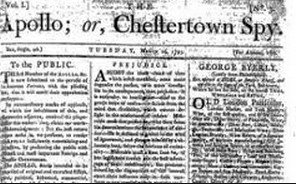We simply could not think of a better name than to pay homage to the first newspaper printed in Chestertown in 1793. Locally owned but international in scope, the original Spy promised that it would report on the daily “occurrences” in and around town, but also gave warning that its charge would be broader than the typical broadside of the day.
 The editor’s opening statement to the public made it clear the Spy would be comprised of essays on the “political, commercial, agricultural, philosophical” topics of the day, and would also include Chestertown’s “poetry, anecdotes, (and)…abstracts of foreign and domestic occurrences.”The Chestertown Spy, second time around, is a 21st century attempt to provide the same service and range of topics to our community in the area of public affairs, local arts, and regional culture.
The editor’s opening statement to the public made it clear the Spy would be comprised of essays on the “political, commercial, agricultural, philosophical” topics of the day, and would also include Chestertown’s “poetry, anecdotes, (and)…abstracts of foreign and domestic occurrences.”The Chestertown Spy, second time around, is a 21st century attempt to provide the same service and range of topics to our community in the area of public affairs, local arts, and regional culture.
It’s more than a tad ironic that Chestertown remains, in many ways, the kind of community one would have found here two hundred-plus years ago.The town had about 3,000 people then, and it has just about 2,000 more now.The county’s population was almost the same size (13,000) as it is now, around 20,000, and we remain an agriculturally driven economy.There was an exceptionally strong, somewhat quirky liberal arts college then, and there continues to be the same one here today.Internationally known scholars, artists, poets, writers, performers, and designers travelled in and out of Chestertown then, as they do now, with regular frequency.The Chestertown Spy intends to capture the knowledge and wisdom of our well-travelled visitors, as did the 18th century Spy, and will celebrate the community’s special interest in things foreign and different.
And while we enjoy these delightful links with the past, Chestertown and its entire Chester River community face challenging and complex choices never possibly contemplated in 1793, or in 1993 for that matter, as the tentacles of urban sprawl from as far away as Philadelphia and Washington begin to be felt on Route 213. We believe the Chestertown Spy can play a useful role in sharing knowledge and resources to our fellow citizens, in the belief that we can only make the best decisions based on the best information.
It must be said that we collectively mourn the possible loss of the traditional physical newspaper, but there is a real need for new alternatives to supplement or even replace its role in community life. While Internet “blogs” have shown some promise in filling this need, they remain all too often the voice of one person rather than the product of journalism.In addition, these community sites rarely take advantage of the full power of the Internet (streaming video, graphics and hyperlinks), which would allow unparalleled access to valuable information.
TheChestertown Spy therefore intends to fill this gap for our small part of the Eastern Shore of Maryland. While we do not see ourselves as a newspaper of record, the Spy intends to provide robust coverage of government, the arts, and culture in a creative and responsible way to answer the region’s need for information. In many ways, our intention is to provide the same kind of coverage as one would find in larger, more urban markets. While this might have seemed almost delusional only a few years ago, we can now realistically state this as our goal, given the remarkable advances in technology and the relatively modest cost of using these tools.
It is not entirely clear why the original publisher settled on the name “Spy” for his newspaper. We speculate, however, that it was the simpler definition of the word: the discovery of something by observation. We expect The Chestertown Spy to continue to provide the community with discoveries, from our own observations, which grow out of newspapers’ oldest traditions.
April 15, 2009

